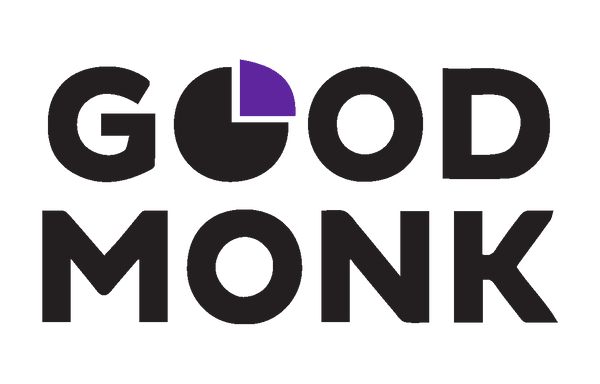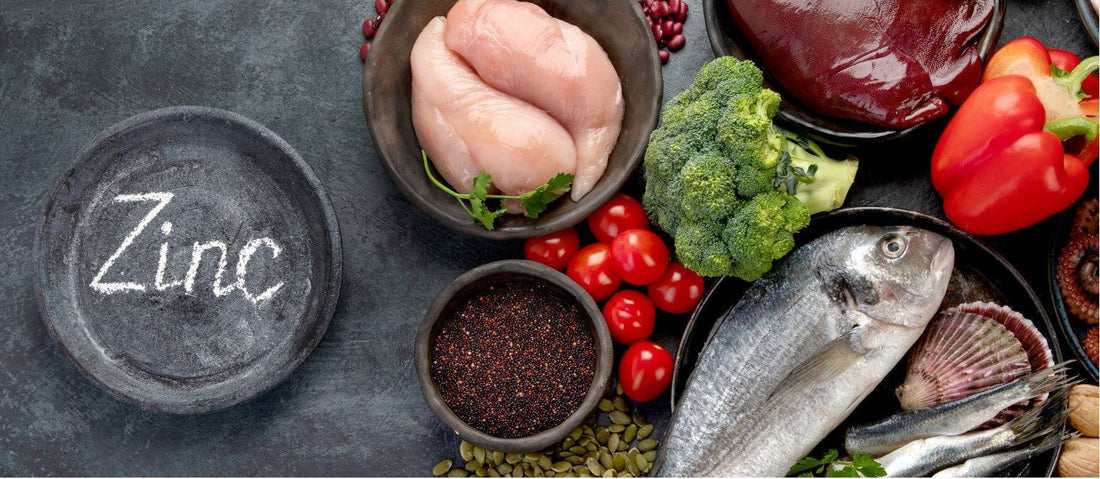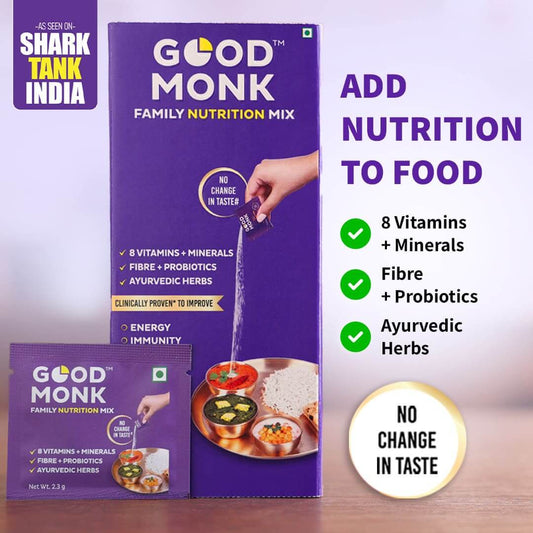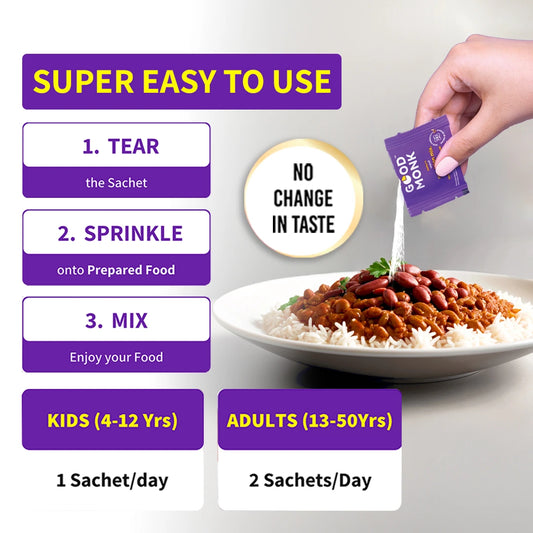Zinc is a vital nutrient that plays an important role in maintaining good health. It supports the immune system, aids in cell growth, and is involved in many body functions. Since your body doesn't store zinc, you need to consume zinc-rich foods, vegetarian or non-vegetarian, every day.
Here’s a guide to understanding zinc, its importance, signs of deficiency, and a list of foods high in zinc to help you fulfil your daily zinc requirement.
What Is Zinc? Why Do You Need It?
Zinc is one of the most essential trace minerals [1] in your body. While your body needs only a small amount of micronutrients like zinc, iron, manganese, copper, iodine, cobalt, fluoride and selenium, they can significantly impact your overall health. Zinc is involved in over 300 enzymatic reactions within the body and is crucial for proper growth, immune function, DNA synthesis, and cell division. One should not overlook the importance of zinc in the human body. [2]
Unlike some minerals, the body does not store zinc. Thus, consuming zinc products such as zinc-rich foods in India is vital for maintaining overall health and preventing deficiencies. You can read more on our blog about vitamins and minerals and their roles in our body.
What Does Zinc Do For The Body?
You must be wondering what does zinc do for the body. Consuming food that contains Zinc has many health benefits for all age groups. Some health benefits of zinc-rich food include:
- Supports immune function.
- Promotes wound healing.
- Aids in DNA synthesis.
- Supports cell division and growth.
- Maintains skin health.
- Enhances taste and smell.
- Contributes to eye health.
- Regulates hormone production.
- Supports reproductive health.
- Reduces inflammation.
- Improves cognitive function.
- Supports cardiovascular health.
- Promotes healthy digestion.
- Aids in nutrient absorption.
- Helps maintain metabolic function.
To further support your digestive health and nutrient absorption. Consider adding a dietary fiber supplement to your routine.
What Are The Signs of Zinc Deficiency In Your Body
Zinc deficiency can lead to a number of health issues. The signs of zinc deficiency include:
- Weakness of the immune system
- Hair loss
- Poor wound healing
- Loss of appetite
- Loss of taste and smell
- Skin rash
- Stunted growth in children.
If you notice any of these symptoms, you should get your zinc levels checked and then modify your diet with zinc-rich vegetables and fruits.

What Foods Have Zinc: Top 20 Foods That Contain Zinc
To get zinc from food, eat more foods that contain zinc. This list of foods high in zinc can be readily incorporated into your meals to support a healthier diet. Let us see what foods have zinc.
Plant-Based Zinc-Rich Foods in India
The Zinc-rich vegetarian food list includes:
1. Chickpeas
Chickpeas are another handy zinc-rich vegetarian food in India. Often used in curries and hummus, this food is high in zinc and offers around 1.3 mg of zinc per cup.
2. Spinach
Spinach is a zinc-rich vegetable and offers 1.4 mg of zinc per cooked cup. It is a smart choice in zinc-rich foods for vegetarians. They are also high in iron, which supports healthy hemoglobin levels.
Read about more iron-rich foods to boost your hemoglobin levels.
3. Mushrooms
Mushrooms, especially shiitake mushrooms, have approximately 1 mg of zinc in every cooked cup. This zinc-rich vegetable is also a good source of fibre, B vitamins and antioxidants.
4. Peas
Peas are another plant-based zinc source that offers around 1 milligram of zinc in every cooked cup. These foods with a lot of zinc are also good for adding protein and fibre to your diet, along with vitamins and minerals such as vitamins C and K.
Zinc-Rich Fruits
Fruits are not the primary source of zinc. A modest amount of zinc is available in:
5. Avocados
Avocados give approximately 0.6 mg of zinc in one fruit. These zinc-rich fruits are also full of healthy fats, fibre, and various vitamins and minerals. Another vegan-friendly zinc-rich food.
Cereals and Dairy Products Containing Zinc
6. Yoghurt
Plain yoghurt contains around 1.4 mg of zinc per cup. It is also a good source of probiotics
7. Dairy Products
Dairy products support strong bones and teeth while also helping your body stay healthy. These zinc products, like milk, cheese, and yoghurt, provide zinc and can be consumed every day or regularly. Add dairy to smoothies, on cereal, or as snacks like cheese and crackers. The zinc in milk can be beneficial for all ages and body types.
8. Fortified Foods
Zinc-fortified foods like breakfast cereals, certain breads, natural drink mixes, and plant-based milk like soy and almond milk contain added zinc. These zinc supplements are a simple way to boost your zinc levels and improve your health.
9. Dark Chocolate
Dark chocolate has approximately 3.3 mg of zinc per 100 grams. It is a sweet way to get zinc and antioxidant benefits.
10. Whole wheat bread
Whole wheat bread offers 1.2 mg of zinc per slice. It can add zinc to your diet without much effort.
Grains, Seeds and Nuts Rich In Zinc
11. Pumpkin Seeds
For those who need plant-based sources of zinc, pumpkin seeds are a great choice of zinc-rich food for vegetarians. They contain around 2.2 mg of zinc per ounce and are excellent options for vegans. This zinc-containing food also has plenty of healthy fats and antioxidants.
12. Almonds
Almonds provide nearly 1 mg of zinc per ounce. This zinc-rich food is a nutritious snack that also contains good fats, vitamin E, and magnesium.
13. Lentils
One of the best vegetarian zinc-rich foods is lentils, which give around 1.3 mg per cooked cup. Lentils make a healthy meal choice as a food that contains zinc.
14. Cashews
Cashews contain 1.6 mg of zinc per ounce. These zinc-rich nuts are also full of good fats, magnesium, and vitamin K, which make them a healthy choice for snacking.
15. Quinoa
Quinoa is a whole grain that provides around 1.1 mg of zinc per cooked cup. This plant-based source of zinc is also a complete protein with all nine important amino acids and fibre, along with many vitamins and minerals.
Meat and Seafood High in Zinc
16. Oysters
Oysters are among the top foods with the most zinc and tops the zinc-rich food list. Six medium-sized oysters (85 grams) provide more than 70 mg of zinc. To increase zinc in the body, oysters are a great option.
17. Beef
Red meat, particularly beef, contains a lot of zinc. Approximately 85 grams of cooked beef can offer around 7 mg of zinc. Beef is one of the best animal-based zinc-rich foods for those who eat meat.
18. Eggs
Eggs are another source of zinc-rich foods in India, with 1 mg of zinc per large egg. Zinc in eggs is a great source of vitamins B and selenium, and makes it a valuable part of zinc-rich diets.
19. Poultry
Poultry items like chicken and turkey are rich in zinc. Chicken has up to 1mg of zinc per 100g. Eating this food with zinc regularly helps boost your immune system and supports healing in your body. It is a great zinc-rich protein choice for non-red meat eaters.
20. Salmon
Cooked salmon provides about 0.5 mg of zinc per 90-gram serving, making it a valuable addition to a balanced, zinc-rich diet. While salmon contains less zinc per serving than red meats or shellfish, it is still a nutritious option, especially for those who prefer fish over other animal proteins. Salmon also offers the added benefits of omega-3 fatty acids, high-quality protein, and essential vitamins, supporting overall health alongside zinc intake.
Zinc Rich Food List Chart
Here is a list of foods with zinc chart for your easy reference.
|
Food with Zinc |
Zinc content |
Zinc food source type |
|
Oysters |
70+ mg per 3 oz |
Animal - Seafood |
|
Beef |
7 mg per 3 oz |
Animal - red meat |
|
Salmon |
0.5 mg per 90 g serving |
Animal - Seafood |
|
Dark chocolate |
3.3 mg per 100g |
Plant based |
|
Pumpkin seeds |
2.2 mg per oz |
Plant-based - seeds |
|
Cashews |
1.6 mg per oz |
Plant-based- nuts |
|
Yoghurt |
1.4 mg per cup |
Animal - Dairy |
|
Spinach |
1.4 mg per cooked cup |
Plant-based - vegetable |
|
Lentils |
1.3 mg per cooked cup |
Plant-based - legumes |
|
Chick peas |
1.3 mg per cup |
Plant-based - legumes |
|
Whole wheat bread |
1.2 mg per slice |
Plant-based - grain |
|
Quinoa |
1.1 mg per cooked cup |
Plant-based - grain |
|
Mushrooms |
1 mg per cooked cup |
Plant-based - fungi |
|
Almonds |
1 mg per oz |
Plant-based - nuts |
|
Eggs |
1 mg per egg |
Animal - poultry |
|
Poultry - chicken |
1mg per 100g |
Animal- poultry |
|
Avocados |
0.6 mg per fruit |
Plant-based - fruit |
|
Fortified foods |
varies |
Mixed |
Zinc-Rich Foods Intake Recommendations
Once you know what food has a lot of zinc, you must learn how much of it you need for daily intake. Daily zinc requirements differ by age, gender and physiological condition according to NIN’s (National Institutes of Nutrition) recommended dietary allowances [3]:
|
Category/Age Group |
Body Weight (Kg) |
Physiological Zinc requirement (mg/day) |
Absorption assumed (%) |
ICMR 2020 (mg/day) |
|
|
EAR |
RDA (mg/day) |
||||
|
Men |
65 |
3.25 |
23 |
14.1 |
17 |
|
Women |
55 |
2.53 |
23 |
11.0 |
13.2 |
|
Pregnant women |
55 |
3 |
25 |
12.0 |
14.5 |
|
Lactating women |
55 |
3.35 |
30 |
11.8 |
14.1 |
|
Infants (0-6 mo) |
5.8 |
- |
- |
- |
- |
|
Infants (6-12 mo) |
8.5 |
0.486 |
23 |
2.1 |
2.5 |
|
Children(1-3 y) |
12.9 |
0.64 |
23 |
2.8 |
3.3 |
|
Children(4-6 y) |
18.3 |
0.85 |
23 |
3.7 |
4.5 |
|
Children(7-9 y) |
25.3 |
1.13 |
23 |
4.9 |
5.9 |
|
Boys(10-12 y) |
34.9 |
1.62 |
23 |
7 |
8.5 |
|
Girls (10-12 y) |
36.4 |
1.64 |
23 |
7.1 |
8.5 |
|
Boys (13-15 y) |
50.5 |
2.75 |
23 |
11.9 |
14.3 |
|
Girls (13-15 y) |
49.6 |
2.46 |
23 |
10.7 |
12.8 |
|
Boys (16-18 y) |
64.4 |
3.38 |
23 |
14.7 |
17.6 |
|
Girls (16-18 y) |
55.7 |
2.72 |
23 |
11.8 |
14.2 |
RDA - Recommended Dietary Allowances
EAR - Estimated Average Requirements
TUL - Tolerable Upper Intake
Even small increases in zinc intake can improve immunity and cognitive function. Accurate dosing is important to avoid deficiency or excess.

How to Maximise Zinc Absorption?
All you need to do is follow these tips to maximise your zinc absorption.
- Choose animal-based foods (meat, poultry, seafood) for higher zinc bioavailability compared to plant sources.
- Consume zinc-rich foods in smaller, more frequent doses to enhance absorption efficiency.
- Pair zinc-rich foods with protein, especially animal protein, to boost uptake and counteract inhibitors like phytates.
- Reduce phytate content in plant foods (grains, legumes) by soaking, sprouting, fermenting, or heating to improve zinc absorption.
- Take zinc supplements on an empty stomach, 1–2 hours before or after meals, for optimal absorption.
- Avoid high-calcium or high-iron foods or supplements at the same time as zinc, as they may compete for absorption.
- Include organic acids (like citrus fruits) in meals to further enhance zinc uptake.
- Monitor zinc status and consult a healthcare professional if deficiency symptoms appear.
Good Monk Nutrition Mixes with Zinc
Are you concerned about how to increase zinc in your body? Good Monk’s scientifically formulated nutrition mixes help to increase zinc intake without changing your entire diet.
Nutrition Mix for Family
The Family Nutrition Mix from Good Monk Nutrition has zinc and other important elements, making sure that everyone gets their daily zinc requirement. The multivitamin with probiotics is made specifically to give well-rounded nutrition to every member of the family.

Nutrition Mix for Seniors
Elders need more nutrients to maintain good health and energy. The Good Monk Nutrition Mix for Seniors has zinc, calcium, and vitamin D, which help with bone health and immune system function. It is the best multivitamin for old age and an effective zinc deficiency food for seniors.

Nutrition Mix for Gut Health & Immunity
The Good Monk Nutrition Mix for Gut Health & Immunity combines the best zinc foods, probiotics, and fibre. This zinc supplement food mix helps maintain good digestion and strengthens the immune system.
Each sachet provides:
- 1.7 mg of zinc in the Family Nutrition Mix – about 11.3% of the average daily requirement
- 3.4 mg of zinc in the Healthy 50+ Mix – about 22.5% of the average daily requirement
Read more about how GoodMonk supports balanced diet goals.
What are the Side Effects of Taking Excessive Zinc?
Every good thing has its side effects, and the same applies to zinc absorption. Some of the major side effects are:
- Nausea and vomiting are common early signs of zinc overdose.
- Stomach pain, diarrhoea, and gastrointestinal discomfort may occur.
- Headaches and dizziness can result from high zinc intake.
- Chronically excessive zinc can lower “good” HDL cholesterol levels.
- Long-term use may suppress the immune system and increase infection risk.
- Copper deficiency may develop, leading to anemia and low white blood cell counts.
- Taste changes, such as a metallic taste in the mouth, are possible.
- Fatigue, lethargy, and weakness may occur with very high doses.
- In severe cases, gastrointestinal bleeding and organ damage are possible.
Conclusion
Eating foods with zinc is essential for good health. You can find this mineral in various zinc food sources, from seafood and meat to seeds and nuts from plants. If you see signs of zinc deficiency, consider taking the right supplements, especially for pregnant women or elderly people who may need more mineral support in their diet. With a balanced diet and the right health mix powder from Good Monk, you can support your body’s need for this vital mineral.
FAQs on Zinc Foods
1. How much zinc should a man consume per day?
Adult men need around 11 mg of zinc according to the National Institutes of Health (NIH).
2. Which food contains the most zinc?
Oysters have the highest zinc content over 70 mg per 100g.
3. What fruit is rich in zinc?
Avocados are zinc-rich fruits that contains approximately 0.6 mg of zinc per fruit.
4. Which vegetables have zinc?
Spinach, mushrooms and peas are among the top vegetables that have zinc.
- Spinach - 1.4 mg per cooked cup
- Mushrooms - 1mg per cooked cup
- Peas - 1mg per cooked cup
5. Can I get enough zinc from a vegetarian diet?
Yes. Vegetarians can meet daily zinc needs by eating legumes, whole grains, vegetables, nuts and seeds. Although plant-based zinc is absorbed less efficiently, vegetarians can meet their needs by regularly including a variety of foods that contain zinc in their diet.
6. How can I increase zinc absorption from plant-based foods?
To increase zinc absorption from plant-based foods, try soaking, sprouting, or fermenting them. These steps reduce phytate levels, which restrict zinc absorption. Also, consuming yeast-based or sourdough bread and pairing zinc-rich foods with vitamin C sources can enhance absorption.
7. How to get zinc from food?
You can get zinc from food by adding zinc-rich foods to your diet. Here are some easy ways to include them.
- Add shellfish, oysters and beef to your meals for the highest zinc content
- Snack on pumpkin seeds, cashews or almonds.
- Include legumes such as chickpeas, lentils or peas in your curries or salads
- Add dark chocolate as a treat to your diet.
8. Are eggs high in zinc?
Eggs contain a good amount of zinc, with one large egg providing about 5–7% of the daily value, making them a useful but not top source of this mineral.
9. How to get 100% daily value of zinc?
You can meet your daily zinc needs by eating foods like shellfish, beef, pork, poultry, legumes, nuts, seeds, dairy products, and fortified cereals as part of a balanced diet.
References
[1] https://www.ncbi.nlm.nih.gov/books/NBK218751/
[2] Kiouri, D. P., Tsoupra, E., Peana, M., Perlepes, S. P., Stefanidou, M. E., & Chasapis, C. T. (2023). Multifunctional role of zinc in human health: an update. EXCLI journal, 22, 809–827. https://doi.org/10.17179/excli2023-6335
[3] https://ods.od.nih.gov/factsheets/Zinc-HealthProfessional/
About the Author
Written by the team at Good Monk—a clean and honest nutrition brand supported by doctors and food scientists. Every product is backed by clinical studies and made to help families eat better, feel better, and live healthier every day.
Popular Searches
Nutrition Powder for Adults | Best Multivitamin Tablets for Old Age | Milk Mix Powder | Family Health Nutrition Combo | Best Fiber Supplement | Drink Mix










